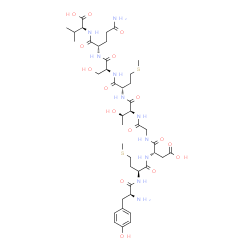TYROSINASE

TYROSINASE structure
|
Common Name | TYROSINASE | ||
|---|---|---|---|---|
| CAS Number | 9002-10-2 | Molecular Weight | 1031.161 | |
| Density | 1.4±0.1 g/cm3 | Boiling Point | 1578.2±65.0 °C at 760 mmHg | |
| Molecular Formula | C42H66N10O16S2 | Melting Point | N/A | |
| MSDS | USA | Flash Point | 908.2±34.3 °C | |
Use of TYROSINASETyrosinase (Polyphenol oxidase) is a rate-limiting enzyme that controls the production of melanin and is encoded by TYR gene. Tyrosinase is mainly found in melanosomes synthesized by skin melanocytes[1]. |
| Name | TYROSINASE |
|---|---|
| Synonym | More Synonyms |
| Description | Tyrosinase (Polyphenol oxidase) is a rate-limiting enzyme that controls the production of melanin and is encoded by TYR gene. Tyrosinase is mainly found in melanosomes synthesized by skin melanocytes[1]. |
|---|---|
| Related Catalog | |
| References |
| Density | 1.4±0.1 g/cm3 |
|---|---|
| Boiling Point | 1578.2±65.0 °C at 760 mmHg |
| Molecular Formula | C42H66N10O16S2 |
| Molecular Weight | 1031.161 |
| Flash Point | 908.2±34.3 °C |
| Exact Mass | 1030.409912 |
| LogP | -1.38 |
| Appearance of Characters | lyophilized powder |
| Vapour Pressure | 0.0±0.3 mmHg at 25°C |
| Index of Refraction | 1.590 |
| Storage condition | −20°C |
| Personal Protective Equipment | Eyeshields;Gloves;type N95 (US);type P1 (EN143) respirator filter |
|---|---|
| Hazard Codes | Xn |
| Risk Phrases | 42 |
| Safety Phrases | 22-24/25-45 |
| RIDADR | NONH for all modes of transport |
| WGK Germany | 2 |
|
Separation of the antioxidant compound quercitrin from Lindera obtusiloba Blume and its antimelanogenic effect on B16F10 melanoma cells.
Biosci. Biotechnol. Biochem. 77(1) , 58-64, (2013) Considering the growing evidence of the presence of antioxidant compounds in plant extracts, the objectives of this study were to identify antioxidant compounds in Lindera obtusiloba Blume (Lauraceae)... |
|
|
The status, quality, and expansion of the NIH full-length cDNA project: the Mammalian Gene Collection (MGC).
Genome Res. 14 , 2121-7, (2004) The National Institutes of Health's Mammalian Gene Collection (MGC) project was designed to generate and sequence a publicly accessible cDNA resource containing a complete open reading frame (ORF) for... |
|
|
Standardised herbal extract of chlorogenic acid from leaves of Etlingera elatior (Zingiberaceae).
Pharmacognosy Res. 3 , 178-184, (2011) Chlorogenic acid (CGA) or 5-caffeoylquinic acid, was found to be the dominant phenolic compound in leaves of Etlingera elatior (Zingiberaceae). The CGA content of E. elatior leaves was significantly h... |
| EINECS 232-653-4 |

